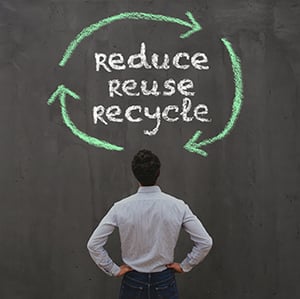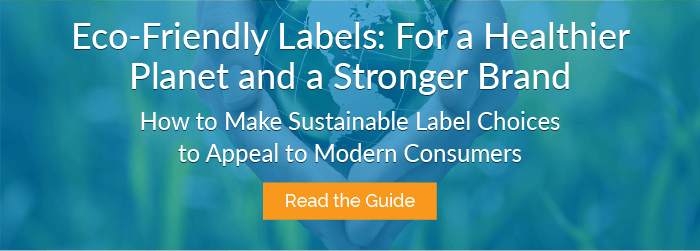
More and more brands are thinking about sustainable product packaging these days, and for good reasons. Sustainable packaging not only helps the planet; it helps brands connect with the rapidly growing segment of eco-conscious consumers.
(As we noted in a previous article, most American Generation Z consumers – those born between 1995 and 2012 – would spend 10% extra or more on sustainable products.)
But the word “sustainable” can mean a lot of things, especially when it comes to labels. The good news? It’s not hard to have a more sustainable label: You just need the right information, which you can get by asking these four questions.
How Do I Need My Label to Perform?
We write about this topic frequently because we believe it is the essential question in label design and the necessary starting point for any label planning. Every product label has a job to do – from attracting new customers to regulatory compliance – and if your label fails to perform its function, its other attributes won’t matter.
In other words, sustainability shouldn’t be your only consideration when choosing a product label. Instead, we suggest working backward from a label design that you know will achieve your objectives and adding sustainable options that will support rather than compromise those goals.
For example, before getting your heart set on a label made from sustainably harvested paper, ask yourself whether paper will hold up in your product’s typical environment. Moisture can quickly reduce a paper label to a pulpy mess, so if your product is commonly stored in steamy bathrooms or damp wine cellars, you might want to select waterproof label materials.
This isn’t to say that sustainable labels perform poorly. Far from it! Many sustainable label choices can also bolster your label’s durability (not to mention shelf appeal). The key is to make sure your label printer is clear on your label’s performance needs. From there, they can suggest ways to ensure your label does its job while minimizing its environmental footprint.
How Do You Define ‘Sustainable’?
More often than not, when customers ask us about sustainable labels here at the Label Printers, they’re referring to recyclable (or recycled) label materials.
Making your label recycle-friendly and constructing it from recycled materials are indeed both ways to boost your label’s sustainability. But sustainability can mean so much more than recycling.
 Leading environmental advocates now think about products – and by extension, product packaging – in terms of a “circular economy.” The circular economy, as defined by the Ellen MacArthur Foundation, “is based on the principles of designing out waste and pollution, keeping products and materials in use, and regenerating natural systems.”
Leading environmental advocates now think about products – and by extension, product packaging – in terms of a “circular economy.” The circular economy, as defined by the Ellen MacArthur Foundation, “is based on the principles of designing out waste and pollution, keeping products and materials in use, and regenerating natural systems.”
The opposite of the circular economy is the linear economy, which takes the Earth’s resources to make products, people use the products, and the products are discarded when they’re no longer wanted.
We can contribute to a more circular, sustainable economy by way of our design choices, according to supporters of the circular economy.
Here are a few ways your product label can help your product become more sustainable:
Encouraging Reusability
Reusability is the gold standard of the circular economy. When we reuse products, nothing goes to waste.
One way to encourage people to reuse your product packaging is by making your label removable. (Your label printer can help you with this.) Certain types of packaging, such as glass jars or sturdy boxes, make attractive household containers, but not when they’re marred by gummy residue or shredded bits of label material.
Reducing Resources
The larger your label, the more resources it consumes. How big does it really have to be?
You can shrink your label’s footprint by removing text and directing your customers to more information online using QR codes or web addresses. You can also conserve ink by opting for just a few bold colors. In our experience, the consumers who value sustainability also tend to appreciate the art of minimalism.
Promoting Recycling
In terms of the waste it generates, recycling typically ranks below reusing and reducing in the waste hierarchy.
While recycling can reduce physical waste, it also consumes energy – both for the recycling process itself and for shipping materials to be recycled. Also, you can’t assume that all plastic product packaging will be recycled everywhere. Recycling systems vary by municipality, as does consumer compliance with recycling guidelines.
(The Association of Plastic Recyclers has an informative guide to creating recyclable product packaging.)
With that in mind, your product label can encourage recycling by communicating the recycling process clearly to your customers (more on that below). You can also support recycling efficiency by choosing label materials, inks and adhesives that will not gum up the works at recycling facilities.
Supporting Composting
Compostable product packaging and composting in general are growing in popularity. If your product packaging is compostable, it’s essential to choose label material and adhesive that will also biodegrade.
Protecting the Environment
If none of the options above are available to achieve your product label objectives, you can at least work with your label printer to choose environmentally benign label elements – that is, materials that will not release any harmful chemicals as they break down in landfills.
Who Is Your Customer, and How Can You Influence Their Actions?
Ultimately, whether your product packaging ends up in a landfill, a recycling center, or a compost pile depends on your customers. We all hope our customers will make the right decisions, but at a certain point, it’s out of our hands.
You can, however, nudge your customers in the right direction, and it starts by knowing who your customers are.
Not everyone has space around their homes for a compost pile, for example. Others may not reside in communities with curbside recycling pickup. These are useful facts to know about your customers when designing sustainable labels.
Once you understand the actions your customers may potentially be willing and able to take, you can think about ways to influence their actions.
If recycling is your goal for example, you might consider joining the How2Recycle initiative. How2Recycle is a standardized labeling system designed to eliminate confusion around the recycling process.
The How2Recycle system uses clear graphics and simple text to tell consumers how to prepare material for recycling, where they can recycle (store drop-off versus municipal program, for example), and the recyclable parts of their product packaging.
How Much Am I Willing to Spend on Sustainable Labels?
Cost is a factor in choosing sustainable labels – as it is with any decision in label printing. Depending on the label materials you choose, there may be minimum order requirements to justify the expense of sourcing those materials.
Your label printer can help you make sustainable label choices that fit your budget and meet your performance expectations. If you work with an experienced label printer (like one that’s been around for over 50 years), you may be surprised by the clever, creative ways in which they can provide you with the best of all worlds.
A More Sustainable Label and a More Sustainable Product
A more sustainable, healthier economy is a circular one – and making your labels more sustainable is a great place to start. Of course, keep in mind that that your label is just one element of your product packaging, and your product packaging is just one element of your product – and how it’s manufactured. Small steps in all these areas can make a big difference.
We’ve touched on just a few of your sustainable label options in this article. Get the complete rundown, along with an analysis of the current consumer demand for eco-friendly labels, in our free 9-chapter guide, “Eco-Friendly Labels: For a Healthier Planet and a Stronger Brand.”




